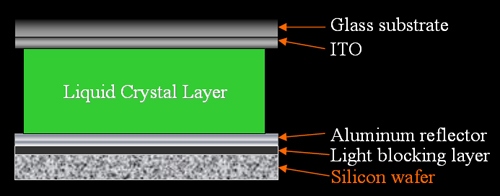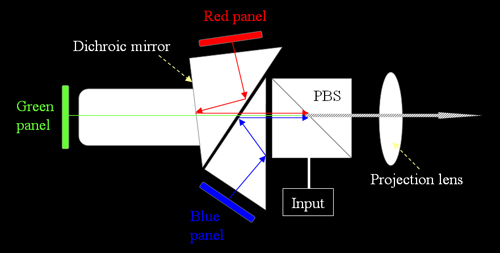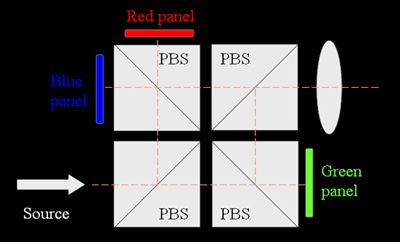ˇˇ[Liquid Crystal on Silicon (LCoS) mode]
An alternative way to achieve high-resolution
LCD is to use the Liquid Crystal on Silicon (LCOS) devices.
LCOS devices use only one glass substrate, and employ a silicon wafer for the
back substrate. The pixels are then generally coated with a
reflective aluminum layer, and then a polyimide alignment layer. Thus, the
liquid crystal industry can take advantage of the existing silicon technology to
produce high resolution microdisplays that is easy and inexpensive to
manufacture. LCoS is widely used in projection display and projector. A simple picture of the optics geometry for an LCOS system is shown
in the figure 1:

Figure 1. A simple Liquid Crystal
on Silicon cell configuration (the TFT structures on the silicon wafer is not
shown).
Microdisplays are likely to be used in a wide range of
applications. The two most likely uses involve virtual displays, in which a
series of passive optical elements is used to project the image from the display
into your eye, and in projectors. In all of these cases, color may be obtained
by one of three realizations:
- Color Pixellization
- Multiple LCOS panels
- Field-Sequential color
The first realization is generally not
adopted by the industry because of the expense
of patterning color filters onto such small displays. The second one is
common in large projectors and projection monitors. The third one is
commonly used with virtual displays. Field sequential color (FSC) consists of
separating color temporally rather than spatially. This requires extremely
fast switching of the LC cell, at least 3 times as fast as a video frame ¨C several hundred Hz. FSC is easily achieved with ferroelectric devices and
MEM devices, but
these are more difficult and expensive to manufacture than nematic LCDs.
There are a few typical optical architectures
which have been using in the LCoS projection system:
- 1). Philips color prism
This set of three coupled prisms is used
in many 3 CCD video cameras to separate and direct the three primary colors to
the three CCDs. In the first application to LCoS projectors IBM developed an
prototype LCoS display based on the Philips prism coupled with a PBS. It
required double pass control of both the polarization and color and at the
same time skew ray compensation for low F number systems. Although extensive
design and prototype work has been done at several companies and in academic
labs, this approach has the difficulty to maintain the polarization state in
the dichroic prism, which results in poor contrast ratio.

Figure 2.
Philips-Color-Prism LCoS projection system
ˇˇ
- 2). Three PBS plus x-cube
The first commercial LCoS front
projectors were designed by IBM, Nikon and JVC. They used dichroic mirrors to
separate the three colors, each of which is directed to the corresponding LCoS
panel with a separate PBS.
Skew rays are corrected for by QWPs between the PBS
and the panel. The reflected images are combined into a full color image in an
x-cube prior to the projection lens. This design is conceptually simple and
allows the optimization of each color channel separately. A recent LCoS RPTV
product has been announced by a major Japanese consumer electronics company
using this design.

Figure 3.
3-PBS/x-cube LCoS projection system
Other versions of this basic design are
under development to eliminate or reduce the skew ray depolarization. Some of
these target lower F number designs and hence higher optical through put.
Others target elimination of the QWPs altogether.
ˇˇ
- 3). Three PBS plus three lenses
In an RPTV application the 3 PBS approach has been modified by
Prokia by replacing the x-cube with three separate projection lenses. In this
case the recombination of the three color images occurs on the rear projection
screen (this is similar to the standard three CRT projection TV). The
advantage of this system is elimination of the x-cube prism and the simpler
projection lenses (albeit there are three rather than one, each with more
limited spectral requirements and shorter back focal lengths). An LCoS RPTV
has been announced with this design.
ˇˇ
- 4). ColorQuad and related architectures
A compact and effective color management system is the
ColorQuad developed by ColorLink. This design utilizes four PBSs and five
polarization selective color filters (Color Select Filters) assembled as a
single unit. The filters and PBSs separate the colors, direct the colors to
the appropriate LCoS panels and recombine the images before they enter the
projection lens. This system is used in the RCA L50000 50ˇ± HDTV. Because the
color separation occurs in the quad this method provides a very compact system
not requiring additional dichroic mirrors. However, it is interesting to note
that the quad and the 3 PBS plus x-cube designs both use four optical prisms.

Figure 4. ColorQuadTM LCoS
projection system
Several related quad-like architectures are under development
by many companies around the world. These include different quad geometries,
replacement of one or more of the PBSs with dichroic cubes or mirrors,
different polarization selective filters, etc. The Hitachi CPSX5500W and JVC
DLA-SX21 are projectors based on versions of the quad-related LCoS
architectures.
5). Off Axis Illumination
PBSs are used in all of the above architectures in order to
separate the incident illumination from the reflected image. S-Vision and now
Aurora have developed a design in which the LCoS panel is obliquely
illuminated. Consequently the incident illumination and reflected image can be
separated without a PBS. This apparently simplified design has its own
challenges. These include more oblique angles at the dichroic color separation
and recombination and a more sophisticated projection lens. Off-axis
projectors have been announced by Aurora and China Display.

Figure 5. Off-axis LCoS
projection system
However, LCoS systems still
have problems, for instance, the life-time is affected because of the high
temperature inside, and the LC director alignment will change as polyimide
morphologies change. This issue has been solved by using inorganic alignment
layer-SiOx. Another issue is the color break-up in the sequential color LCoS
system, which is also called "rainbow effect", as appearing in single panel DLP
system. Moreover, the optical engine design is complex, in order to accurately
control the state of polarization.
Further Readings
and References:
IBM, "Special
session for high-resolution displays", IBM J. Res. Dev., 42, no. 3/4
(1998).
M. R. Greenberg and
B. J. Bryars, "Skew ray compensated color-separation prism for
projection display applications", SIDˇŻ00, Digest, pp.88¨C91 (2000).
M. F. Bone, M.
Francis, P. Menard, M. E. Stefanov, and Y. Ji, "Novel optical system
design for reflective CMOS technology", Proceedings of 5th Annual
Flat Panel Display Strategic and Technical Symposium, p.81 (1998).
R. L. Melcher, M.
Ohhata, and K. Enami, "High-information-content projection display
based on reflective LC on silicon light valves", SIDˇŻ98, Digest,
pp.25¨C28 (1998).
C. L. Bruzzone, J.
J. Ma, D. J. W. Aastuen, and S. K. Eckhardt, "High-performance LCOS
optical engine using Cartesian polarizer technology", SIDˇŻ03,
Digest, pp.126¨C129 (2003).
C. L. Bruzzone, J.
J. Schneider, and S. K. Eckhardt, "Photostability of polymeric
Cartesian polarizing beam splitters", SIDˇŻ04, Digest, pp.60¨C63
(2004).
M. Robinson, J.
Korah, G. Sharp, and J. Birge, SIDˇŻ00, Digest, pp.92¨C95 (2000).
G. Sharp, M.
Robinson, J. Chen, and J. Birge, "LCOS projection color management
using retarder stack technology", Displays, 23, pp.139¨C144 (2002).
ˇˇ